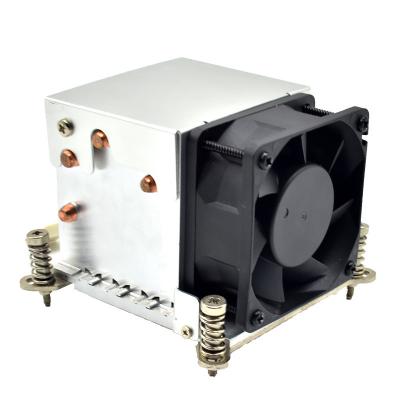







| Price | EXW/FOB/CIF/DDP |
| MOQ | Negotiable |
| Delivery Time | 20-30days |
| Brand | Customized |
| Place of Origin | China |
| Certification | ISO9001:2015 |
| Model Number | HEAT SINK-H0015 |
| Packaging Details | Blister packaging |
| Payment Terms | T/T, Western Union |
| Supply Ability | 30000 PCS Per month |
| Place of Origin | China | Delivery time | 20-30days |
| Keyword | heat pipe radiator | Packaging Details | Blister packaging |
| Model Number | HEAT SINK-H0015 | Supply Ability | 30000 PCS Per month |
| Processing Service | Cutting, CNC,Anodizing | Certification | ISO9001:2015 |
| Brand Name | Customized | Payment Terms | T/T, Western Union |
| Raw Material | AL5052/AL1050/Cooper | Price | EXW/FOB/CIF/DDP |
| Delivery Time | 20-30days | Minimum Order Quantity | Negotiable |
| Surface Treatment | Plating Nickel | Application | heat sink |
Exsiting Single Fan CPU Heat Pipe Radiator With Screws For Easy To Install
Quick Detail
| Raw Material | AL5052 and 4 heat pipe |
| Custom Service | Yes, OEM/ODM Service |
| Quality System | ISO9001:2015 |
| Processing Technology | Cutting/Wood machining/CNC/Riveting |
| Surface treatment | plating nickel |
| Packing Way | Blister packaging or special packing you would like |
| Application Scenario | Electronic equipment heat sink |
| MOQ Request | 100/500/1000 |
Description
Heat pipe radiator is a new product produced by using heat pipe technology to make major improvements to many old radiators or heat exchange products and systems. There are two types of heat pipe radiators: natural cooling and forced air cooling. The thermal resistance of air-cooled heat pipe radiator can be made smaller, and it is often used in high-power power supplies.
Note
Air
cooling
+
heat
sink
type
Ordinary
"fan
+
heat
sink"
structure
radiator
"fan
+
heat
sink"
structure
has
a
long
history.
It
has
been
used
on
a
large
scale
since
the
birth
of
the
graphics
card,
and
it
has
been
in
use
ever
since.
In
addition
to
changes
in
volume
and
craftsmanship,
its
basic
layout
is
still
"fan
+
heat
sink".
The
early
"fan
+
heat
sink"
structure
belonged
to
a
more
"regular"
type.
For
example,
a
large
piece
of
cast
aluminum
or
copper
core
is
matched
with
cast
aluminum
heat
dissipation
fins
to
form
a
round
or
square
appearance,
and
then
a
fan
is
placed
in
the
middle
circular
groove.
The
biggest
advantage
of
this
classic
structure
is
that
it
can
make
good
use
of
the
wind
flow.
The
wind
blowing
around
the
fan
can
take
away
the
heat
on
the
heat
sink.
As
the
graphics
card
heats
up,
it
is
difficult
to
quickly
dissipate
heat
simply
relying
on
the
heat
sink
and
the
fan.
Therefore,
some
manufacturers
have
made
improvements
to
the
structure
of
the
heat
sink.
A
common
improvement
method
is
to
press
and
fix
the
aluminum
and
copper
sheets
to
form
a
bowl-shaped
structure,
and
place
the
fan
in
the
center
of
the
"bowl".
Compared
with
the
traditional
thick
fin
structure,
this
structure
has
a
larger
heat
dissipation
area
and
a
better
heat
dissipation
effect.
Although
the
"fan
+
heat
sink"
structure
is
classic,
it
also
has
disadvantages.
First
of
all,
this
structure
relies
solely
on
the
thermal
conductivity
of
the
metal
itself,
and
cannot
conduct
heat
away
in
time
when
facing
the
high-power
core,
resulting
in
a
backlog
of
heat
in
the
core
and
insufficient
heat
conduction
efficiency.
Secondly,
the
heat
dissipation
area
of
the
heat
sink
of
this
structure
is
difficult
to
increase.
Although
large-area
fins
can
be
used
and
multi-fan
mode
can
be
used
to
enhance
the
airflow,
the
farther
the
heat
sink
is
from
the
core,
the
worse
the
heat
dissipation
efficiency,
and
the
heat
is
difficult
to
evenly
distribute
to
the
heat
dissipation.
Chip.
Advantages:
low
price,
wide
application,
diverse
designs.
Disadvantages:
Poor
heat
dissipation
for
high-power
graphics
cards,
prone
to
heat
accumulation.
The heat pipe radiator has the following advantages:
We can offer the heat pipe radiator service, small qty is acceptable.




Technical Support
We can offer the design and simulation service. For example, our German customer's case.
According to the simulation results,the simulated chip is in compliance with the temperature requirements specficied by customer.
